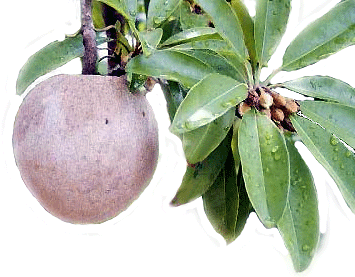 Sapodilla Manilkara zapota van Royen,
Chicozapote
Sapodilla Manilkara zapota van Royen,
Chicozapote
The sapodilla is believed native to Yucatan and possibly other nearby
parts of southern Mexico, as well as northern Belize and Northeastern
Guatemala. The sapodilla is found in forests throughout Central America
where it has apparently been cultivated since ancient times. The
Sapodilla comes from chicle tree from which white latex is taken for
making chewing gum. Nowadays North American chewing gum base is synthetic,
but the persnickety Japanese still buy the natural thing.
Sapodilla was introduced long ago throughout tropical
America and the West Indies, the Bahamas, Bermuda, the Florida Keys and
the southern part of the Florida mainland. During their occupation of the
Philippines, the Spaniard brought this fruit to the country and eventually
it was exported to the rest of region.
Sapodilla has a thin peel and brown and the flesh itself
is light brown. It is best eaten a couple days after it is picked, to wait
for its resin to dry. When ripe, the fruit is juicy, very sweet, and
has a pear or molasses-like taste. Generally, the ripe sapodilla,
unchilled or preferably chilled, is merely cut in half and the flesh is
eaten with a spoon. It is an ideal dessert fruit as the skin, which is not
eaten, remains firm enough to serve as a "shell".
The fruit may be nearly round, oval, or conical; varies
from 2 to 4 in (5-10 cm) in width. When immature it is hard, gummy and
very astringent. Though smooth-skinned it is coated with a sandy brown
scurf until fully ripe. The flesh ranges in color from yellowish to light-
or dark-brown or sometimes reddish-brown; may be coarse and somewhat
grainy or smooth. Some fruits are seedless, but normally there may
be from 3 to 12 seeds which are easily removed.





















































